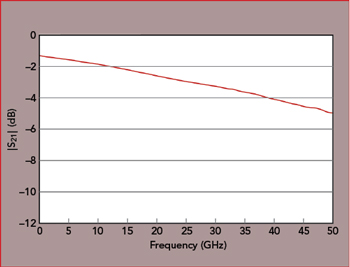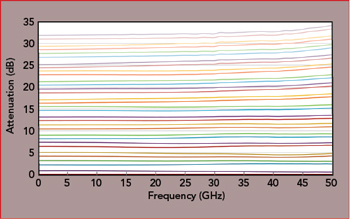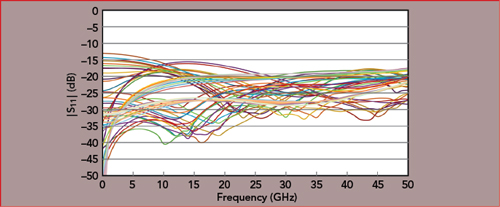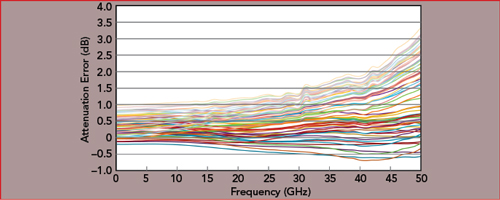With the rollout of 5G, the mobile industry will expand beyond sub-6 GHz to support mmWave frequencies. mmWave signals often suffer increased attenuation passing through walls and structures, and semiconductor device technologies are inherently frequency-limited, creating both system design and implementation difficulties. Overcoming these hurdles requires technologies like beamforming and massive MIMO, backed by commercially viable and reliable passive components tailored to the high frequency signal chain.
To serve the evolving mmWave demands of 5G, pSemi (formerly Peregrine Semiconductor) has introduced several high frequency components, including a 40 GHz switch (PE42524) and two 60 GHz switches (PE42525 and PE426525). The newest product in this portfolio is a 50 GHz digital step attenuator (DSA): PE43508. These monolithic ICs are ideal for applications, such as test and measurement and 5G wireless infrastructure, and can be used in more traditional high frequency applications, such as very small aperture satellite terminals.
pSemi’s mmWave switches and new DSA are manufactured on the company’s Ultra-CMOS®platform, a patented variation of silicon on insulator (SOI) technology, and contain industry-leading innovations in RF SOI switch design. The PE43508 DSA is based on the 300 mm UltraCMOS 12 technology platform that delivers RonCoff, a key figure of merit for RF switches, of 80 fs, surpassing the SOI competition.
Traditionally, GaAs solutions have ruled the high frequency domain, but the pSemi mmWave portfolio proves that RF SOI can deliver high performing and reliable solutions at mmWave frequencies. Introduced in 2015, the PE42524 was the industry’s first RF SOI switch to operate up to 40 GHz, and it offered design engineers the first alternative to GaAs switches at K- and Ka-Band. The PE42525 and PE426525 surpassed this milestone by supporting a wider frequency range from 9 kHz to 60 GHz, delivering exceptional performance in all key RF parameters and attaining a fast switching speed of only 8 ns.
DSA FEATURES

Figure 1 Example showing contributions from each of four formation to each transmitters to each of four receivers.

Figure 2 Example showing contributions from each of four formation to each transmitters to each of four receivers.
Now, pSemi has broadened its mmWave portfolio with the introduction of the PE43508, the industry’s first single-chip DSA to support the 9 kHz to 50 GHz frequency range. Single-chip DSAs are a product category pSemi first introduced in 2004—since proven to be more optimal in RF performance than discrete components. In an RF chain, a DSA controls the signal amplitude by setting the desired attenuation to deliver the proper power level to the next component in the signal chain. The goal is to control the signal level accurately, with minimal attenuation error.
The PE43508 is a 6-bit, 50 Ω DSA with a 31.5 dB attenuation range in 0.5 and 1 dB steps. It features low insertion loss, low attenuation error and good return loss, and it maintains a monotonic response across the entire frequency range. Figure 1 shows the 0 dB attenuation (reference state) insertion loss through 50 GHz at room temperature. Figure 2 shows the attenuation versus frequency for each 1 dB step, where the attenuation is normalized to the reference state (i.e., the measured insertion loss minus the loss of the reference state at the same frequency). Figure 3 plots |S11| for all attenuation states, and Figure 4 shows the attenuation error for all states.

Figure 3 |S11| vs. frequency.

Figure 4 Attenuation error vs. frequency.
Leveraging pSemi’s patented HaRP™ technology enhancements, the DSA delivers high-power handling and high linearity. At room temperature, the PE43508 has a maximum CW input power of +28 dBm from 1 to 50 GHz, with a typical input IP3 of +51 dBm at 16 GHz and a 1 dB compression point of +32 dBm at 50 GHz. Other features are a fast switching time of 350 ns, with glitch-safe attenuation state transitions—meaning no increased power spike during a state transition. The PE43508 has an extended temperature range from −40°C to +105°C, an HBM ESD rating of 1 kV and an easy-to-use digital control interface supporting both serial addressable and parallel programming. The DSA supports 1.8 V control signals and has an optional VSS_EXT bypass mode to improve spurious performance.
Offered as a flip chip die, the PE43508 uses lead-free solder ball technology for the signal and ground interconnects. Solder reflow profiles common to lead-free surface-mount assembly can be used to achieve uniform and reliable attachment. Since the material composition of the DSA is similar to alumina (Al2O3), the coefficients of thermal expansion for the two materials are similar, 5 to 7 ppm/°C (or 5 to 7 x 10−6/°K), ensuring a mechanically reliable and robust interconnect. The PE43508 is configured with a 500 µm minimum ball pitch. While thin film technologies can readily meet the line width and spacing critical dimensions (CD) of 100 µm or less, thick film and PCB processes generally require far less stringent CDs to achieve reasonable and consistent manufacturing yields. The comparatively wide 500 µm ball pitch of the PE43508 is intended to support the larger CD requirements and enable assembly of the die directly to RF PCB boards. pSemi has written an application note, available on their website, discussing the recommended landing patterns and assembly process for obtaining peak performance with alumina and PCB assemblies.
Volume production quantities, evaluation kits and samples of the PE43508 are available. In 1000 quantity orders, the PE43508 is priced at $50.
pSemi Corp.
San Diego, Calif
www.psemi.com
sales@psemi.com
